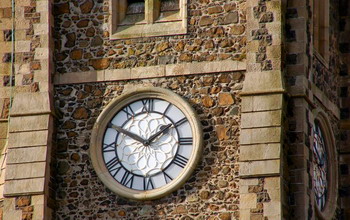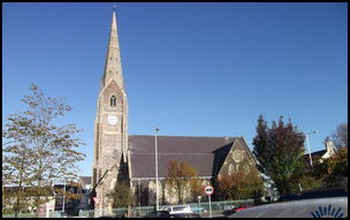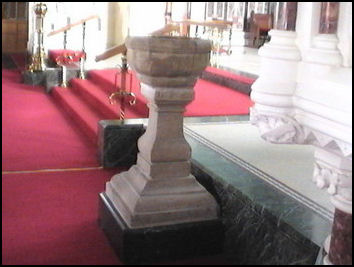|
Shankill Parish Church
by S.J. Malcolm
The "Big Church"

Any visitor to Lurgan cannot fail to be impressed by the magnificent Church of Christ the Redeemer, reputedly the largest Church of Ireland church excluding cathedrals in Ireland. A church for Shankill Parish has occupied this site since 1725 and the present building replaced the first church in 1863 with the tower of the old church incorporated.
The rugby legend Dr. Jack Kyle, arguably Ireland's greatest player, until the advent of Brian O'Driscoll, current captain, served a post graduation year in Lurgan Hospital. He asserts the everlasting memory he has when he thinks of Lurgan is the majestic Parish Church occupying the centre of Lurgan
The building of the 1725 church cost £2000. The next one( the present church) cost £8000 in 1863. A conservative guess as to the cost of replacing this beautiful church would be £5 million.
Here is a potted history of Shankill Parish, Lurgan:
 After the old Irish nobles left their native land in 1607 from Rathmullen in Donegal, "The flight of the Earls", the English Parliament decided to colonise Ulster with "planters". Large areas of the escheated lands were offered to English and Scottish settlers or "undertakers"
Those of Scottish regions did not wish to travel far in Ulster from their homelands so they chose counties Antrim and Down to settle. To this day people in places like Ballymena in Antrim and Kilkeel in Down speak with a Scots accent so different from the rest of Ulster. They were also Presbyterian and even yet settler towns in Antrim and Down are principally of Presbyterian outlook. Lurgan was different. Quite some distance from the coast, it was generally Anglicans who settled County Armagh. John Brownlow
arrived in 1609 and undertook to settle Lurgan. For worship they went to Oxford Island to a very ramshackle old building there. This proved most unsuitable and soon a better one was erected in what is now Shankill graveyard, closer to the town. After the old Irish nobles left their native land in 1607 from Rathmullen in Donegal, "The flight of the Earls", the English Parliament decided to colonise Ulster with "planters". Large areas of the escheated lands were offered to English and Scottish settlers or "undertakers"
Those of Scottish regions did not wish to travel far in Ulster from their homelands so they chose counties Antrim and Down to settle. To this day people in places like Ballymena in Antrim and Kilkeel in Down speak with a Scots accent so different from the rest of Ulster. They were also Presbyterian and even yet settler towns in Antrim and Down are principally of Presbyterian outlook. Lurgan was different. Quite some distance from the coast, it was generally Anglicans who settled County Armagh. John Brownlow
arrived in 1609 and undertook to settle Lurgan. For worship they went to Oxford Island to a very ramshackle old building there. This proved most unsuitable and soon a better one was erected in what is now Shankill graveyard, closer to the town.
In the latter part of the seventeenth century, the population of Lurgan grew quickly and the parishioners of Shankill found their little church too small. It was either necessary to enlarge the existing building or build a new church. It became evident however it would not be possible to extend the old church as the graves had been made under the shadows of the walls. A building on a new site was the only solution, but the consent of the Irish Parliament was necessary. Arthur Brownlow engineered this and an act was passed giving the requisite permission. The site chosen was" The Green Of Lurgan". This was located where "The Street of Lurgan",(Market Street) "the Back Lane"(North Street), "the Road to Lough Neagh (William Street) and the road leading over the "Pound" (Edward Street), met.
 Building of the new church commenced in 1720 and was completed in 1725. On 8th August that year the building was consecrated by Ralph Lambert, Bishop of Dromore. The Deed of Consecration is extant and is in the archive of the present church. The new church was named Christ's Church and the Rector was an Englishman John Wetherby. He was rector for 10 years until his death in 1735. Incidentally, there have been 27 rectors of Shankill since 1610.
In 1734 the timber of the old church was sold for £25 and the stones used to build a tower for the new church, which still stands today. In 1737 a spire was erected and a clock installed. The font, a gift of a former Rector Legard Blacker and dated 1684, is still used to this day.
The spire has a chequered history. The timber one erected in 1756 was destroyed by fire in 1792. Apparently a workman was working inside the spire with a brazier and went home forgetting about the living fire he had left. The spire was set on fire and the large bell, used to summon parishioners to worship, fell through the floors to ground level. It was red hot and some well meaning souls doused it with cold water and it cracked.
The reconstruction saw 20 feet added to the height of the tower and a new timber spire erected. Another fabled night of the "big wind" put paid to this spire in 1839. The spire was then rebuilt and lasted till 1861 when the existing church was dismantled with the exception of the tower. The stone of that tower can still be seen today as completely different from the new basalt church it enhances. Building of the new church commenced in 1720 and was completed in 1725. On 8th August that year the building was consecrated by Ralph Lambert, Bishop of Dromore. The Deed of Consecration is extant and is in the archive of the present church. The new church was named Christ's Church and the Rector was an Englishman John Wetherby. He was rector for 10 years until his death in 1735. Incidentally, there have been 27 rectors of Shankill since 1610.
In 1734 the timber of the old church was sold for £25 and the stones used to build a tower for the new church, which still stands today. In 1737 a spire was erected and a clock installed. The font, a gift of a former Rector Legard Blacker and dated 1684, is still used to this day.
The spire has a chequered history. The timber one erected in 1756 was destroyed by fire in 1792. Apparently a workman was working inside the spire with a brazier and went home forgetting about the living fire he had left. The spire was set on fire and the large bell, used to summon parishioners to worship, fell through the floors to ground level. It was red hot and some well meaning souls doused it with cold water and it cracked.
The reconstruction saw 20 feet added to the height of the tower and a new timber spire erected. Another fabled night of the "big wind" put paid to this spire in 1839. The spire was then rebuilt and lasted till 1861 when the existing church was dismantled with the exception of the tower. The stone of that tower can still be seen today as completely different from the new basalt church it enhances.
There occurred in the Province of Ulster about 1869 a great spiritual revival. According to records, worship before that time had slipped to anything but a God centred base when two evangelists arrived in Ulster with fire in their bellies. Before long, crowds were expectantly awaiting their meetings, often held in the open air with perhaps 7,000 attending. During this outpouring of newly acquired spiritual zeal, it is reported that 100,000 people were converted in Ulster alone while the rest of Ireland was unmoved. Similar outpourings were occurring in Scotland, Wales and Northern England. Perhaps it is no surprise that the people of Lurgan reacted also. The Anglicans (Church of Ireland) felt their building too small, led by the Brownlow family. It is probable that the petition to the Ecclesiastical Commissioners for a new church was brought about by the prompting of Lord Lurgan and his family. Thus it was at the acquiescence of the said Commissioners that the foundation stone of the new church was laid in 1861. The church was built around the walls of the old church, which was then demolished on completion of the new edifice. Taking two years to complete, Shankill's congregation was accommodated in the town's Methodist and Presbyterian churches. This must have put a tremendous strain on everyone involved but apparently all went fairly smoothly until the building was completed in 1863 at the colossal cost, for those days, of £8,000. The church was constructed of local basalt, incidentally used also for St.Peters. Basically symmetrical in plan form it is 38.5 metres in length and 27.25 metres wide. The spire is 180 feet high (55m) and may be easily seen from across Lough Neagh at Arboe Cross on a good day. The Primate, Archbishop Knox - his brother Rev Thomas Knox was rector of Shankill at the time, consecrated the new structure in 1863, dedicated to Christ the Redeemer. It was such a large building at that time, the capacity was just short of 2,000.
L inen in the 1800's was the main provider of employment in Lurgan and the "linen lords" were mostly members of the Church of Ireland. At the opening of the new church in 1863, James Malcolm, ancestor of the writer, presented the weather cock and the magnificent Walker organ to the Church. The same organ which will be 150 years old in 2013 is the subject of an appeal for £150,000 for repairs. A comparable new organ would cost over £1million. Francis Watson presented in 1873, the beautiful windows depicting the four evangelists. The large central window shows the Apostles Mark and Luke and is 28 feet high. The 22 feet high windows on either side have Matthew and John. These windows by Meier of Munich were severely damaged by bomb blast in the 1970's. However they were removed from their housing and successfully restored to their former glory. The Johnston family, of Johnston and Allen fame, added stained glass windows in 1989, depicting a weaving factory. The Brownlow family and several Lords Lurgan were intimately connected with Shankill Parish. A stained glass window on the south side of the chancel represents Faith, Hope and Charity - sacred to the memory of Rt. Hon. Charles Brownlow, Baron Lurgan 1847. In 1937 the beautiful oak vestibule was presented by 3rd Lord Lurgan and in 1985 the side chapel was added by his successor. It was designed by parishioner Thomas Donnell, Diocesan Architect. inen in the 1800's was the main provider of employment in Lurgan and the "linen lords" were mostly members of the Church of Ireland. At the opening of the new church in 1863, James Malcolm, ancestor of the writer, presented the weather cock and the magnificent Walker organ to the Church. The same organ which will be 150 years old in 2013 is the subject of an appeal for £150,000 for repairs. A comparable new organ would cost over £1million. Francis Watson presented in 1873, the beautiful windows depicting the four evangelists. The large central window shows the Apostles Mark and Luke and is 28 feet high. The 22 feet high windows on either side have Matthew and John. These windows by Meier of Munich were severely damaged by bomb blast in the 1970's. However they were removed from their housing and successfully restored to their former glory. The Johnston family, of Johnston and Allen fame, added stained glass windows in 1989, depicting a weaving factory. The Brownlow family and several Lords Lurgan were intimately connected with Shankill Parish. A stained glass window on the south side of the chancel represents Faith, Hope and Charity - sacred to the memory of Rt. Hon. Charles Brownlow, Baron Lurgan 1847. In 1937 the beautiful oak vestibule was presented by 3rd Lord Lurgan and in 1985 the side chapel was added by his successor. It was designed by parishioner Thomas Donnell, Diocesan Architect.
Tablets on the wall commemorate Deans Campbell and O'Loughlin, both long serving rectors of Shankill. Incidentally it was mentioned that Shankill has had 27 rectors. The longest serving was Holt Waring of the illustrious Waringstown connection who served 52 years and two men only lasted for one year. Was the post too exacting for them?
The font as we have said, dates from 1684 and was originally in the" Shankill Graveyard " church. A communion goblet dating 1694 exists. The beautiful white slate pulpit was erected in 1898 and the original wooden one transferred to Kilmore where it is still in use. A magnificent golden eagle lectern welcomes those who have to read the lesson from it. When the first church was built a drum was used to summon worshippers. Subsequently a bell weighing 100 lbs was erected in the Market house. When the 1725 church was built the bell was brought to this building. James Ussher, a Lurgan solicitor persuaded Select Vestry members to back him in his efforts to procure a peal of 8 bells, commensurate with Shankill Parish's standing as one of the great Anglican churches in Ireland. So in 1875 Mr Ussher undertook to collect £800 for the provision of bells. He collected £600 in a few months and God looked down on his project. A Mr. Watson, relative of Francis Watson who donated the large East window, and domiciled in New York, made up the shortfall of £200. Thus the eight bells ranging from 21 ½ cwt to less than half that, were enabled to be erected in 1877, and have been an adornment to the church ever since. In 1950 a carillon, playing 8 different hymn tunes was added - the gift of Mr D.J.Kyle.
1932 saw the remodelling of the chancel, new communion rails and beautifying of the sanctuary. In the early 60's, choir stalls were positioned in memory of James Johnston J.P and the opportunity was taken to relocate the organist and choir from the gallery to the newly installed choir stalls next to the chancel. This meant that the choir were much closer to the congregation.
1996 was the year when work commenced to provide a number of amenities within the church. There had been a poor provision of toilets and this was rectified together with an enlarged narthex and choir rooms. This has allowed the modern trend of "coffee at a meeting place" after morning service and is much availed
 Actuality of the present time is that after standing for almost 150 years, the mortar binding the old blocks of the spire had become dusty and unsafe. It was propounded that a "big big" wind could have removed a large part of the spire, with consequent damage to all below and a huge insurance claim. The top 17 rows of blocks had been subjected to one and a half centuries of acid rain and become very porous When these blocks were removed, it was found that more blocks were not up to required quality. So after a year's work, the scaffolding was finally removed in August 2011, and various cosmetic alterations done to the building. Much of the sandstone has been cleaned and contrasts well with the basalt of the building.
The Church of Christ the Redeemer ,Shankill Parish will (DV) celebrate its 150th anniversary in 2013, the second church on the site since 1725 and a continued landmark on the face of Lurgan. Actuality of the present time is that after standing for almost 150 years, the mortar binding the old blocks of the spire had become dusty and unsafe. It was propounded that a "big big" wind could have removed a large part of the spire, with consequent damage to all below and a huge insurance claim. The top 17 rows of blocks had been subjected to one and a half centuries of acid rain and become very porous When these blocks were removed, it was found that more blocks were not up to required quality. So after a year's work, the scaffolding was finally removed in August 2011, and various cosmetic alterations done to the building. Much of the sandstone has been cleaned and contrasts well with the basalt of the building.
The Church of Christ the Redeemer ,Shankill Parish will (DV) celebrate its 150th anniversary in 2013, the second church on the site since 1725 and a continued landmark on the face of Lurgan.
Samuel Malcolm is Archivist and Chief Historian of Shankill Parish Church. We give our warmest thanks to him and to "The Big Church" for their permission to use this article.


|

